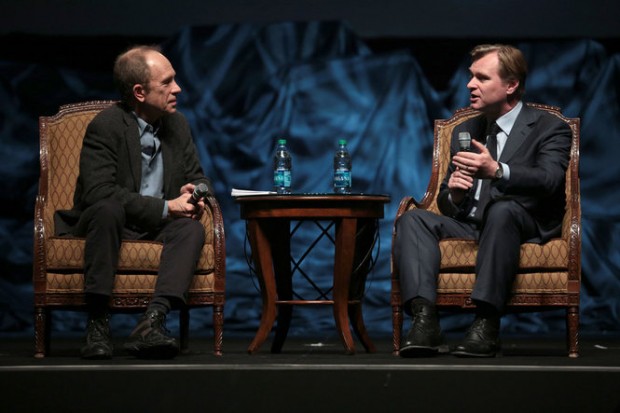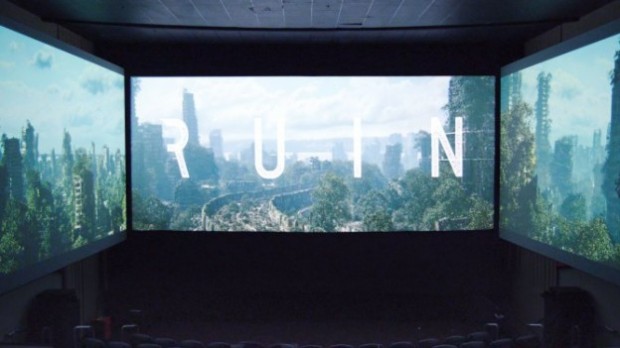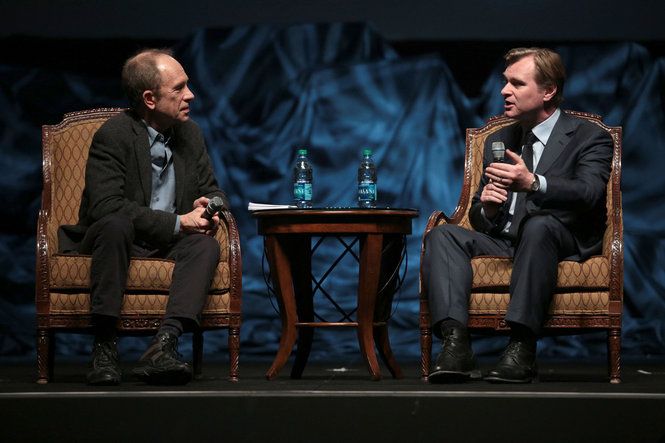
The general mood and tone of the reporting out of CinemaCon, last week’s Las Vegas-based conference for movie theater owners, is essentially, “well, what’s next?” With two anxieties — international piracy and the digital transition — quelled, the focus appears to be on new apps like recliner seating, laser projection, 4D, advertising, growing attendance and living in harmony with other “screens.”
With 93% of screens converted to either 2K or 4K digital projection, the best-capitalized exhibitors led the way in consolidating operations. Since last year’s CinemaCon, we’ve seen the purchase of multi-state chains — including Rave Cinemas, Hollywood Theatres, Muvico, and Clearview Cinemas — fundamentally change NATO’s trade Box Office Magazine’s annual top 50 “Giants of Exhibition,” which can be read here.
Consider the most drastic spread in the history of exhibition: this year’s “Giants” is lead by the nation’s largest company, Regal Entertainment Group, with 7,382 screens, while California-based regional player Krikorian rounds out the top 50 list with just 92 screens. The digital transition and increased consolidation has led to a climate of experimentation with alternative content, including exhibitors, getting into the distribution business, from AMC’s limited releases to Regal’s Open Road, which widely distributes independently-financed films in the $10-$50 million dollar range.
As reported by THR, Universal International president David Kosse called upon exhibitors to invest in VOD. In essence, to become distributors themselves. Smaller exhibitors have acquired features to fill their screens while also building long-term value by owning the auxiliary rights. These divisions include Digiplex Destination’s Diginext (releasing mostly documentaries, recently in partnership with Screenvision) and the Alamo Drafthouse’s Drafthouse Films, which releases a diverse array of features including documentaries, camp narratives, new international cinema and restored cult classics, all while leveraging multiple platforms such as VOD/PVOD (in partnership with Cinedigm) and theaters.
While piracy remains an industry enemy, it appears to no longer be quite the boogeyman it had been to global box office. The MPAA reported global gains of 4%, including a significant 27% increase in China, as the nation continues to partner with Hollywood, relax quota laws and construct new high-tech cinemas. One implication that should continue is the increasing relevance of films that play globally, even if they seem to flop domestically.
 The domestic numbers were slightly grim, as movie-going subscription service MoviePass CEO Stacy Spikes (pictured right) told us, “We’re still trending in the wrong direction.” While domestic revenues increased 2%, admissions decreased by 1%, along with 3% decrease in attendance per capita, marking a 17% negative growth over the past 10 years. A sharp 21% decrease in regular moviegoing for 18-to-24-year-olds was offset by 53% growth for family features, led by hits like Frozen and Despicable Me 2.
The domestic numbers were slightly grim, as movie-going subscription service MoviePass CEO Stacy Spikes (pictured right) told us, “We’re still trending in the wrong direction.” While domestic revenues increased 2%, admissions decreased by 1%, along with 3% decrease in attendance per capita, marking a 17% negative growth over the past 10 years. A sharp 21% decrease in regular moviegoing for 18-to-24-year-olds was offset by 53% growth for family features, led by hits like Frozen and Despicable Me 2.
Spikes believes his company, which initially had a few false starts, may help buck the negative growth trend amongst millennial, as 75% of his customers are 18 to 34. On average, MoviePass subscribers in the 18-to-34 age range have increased their concessions, spending 125% more, and go to movies 64% more, quadrupling the infamously slow mid-week attendance. “A lot of it has to do with millennial thinking. The consuming of media has been different their entire life. Here’s Netflix, here’s Hulu, here’s Spotify, and all of the platforms are access-based in a fixed, flat universe verses hit-driven and a la cart,” Spikes tells us. The subscription concept, Spikes notes, have been successful elsewhere, with the UK-exhibitor Cineworld claiming 20% of its attendance comes from the similar “Unlimited Card.” Apart from advanced level memberships at mostly not-for-profit art houses, the only commercial chain exhibitor in the US to adopt a similar model is the 54-screen Buffalo, NY-based regional exhibitor Dipson Theaters, which sells its season pass for $450 a year (MoviePass, by comparison, offers monthly rates $25 to $50 based upon zip code and membership duration, and allow a member to see one film per 24-hour period).
NATO chief John Fithian has also called for a discount night, widely in place amongst the top ten exhibitors, including most locations operated by Bow Tie Cinemas, National Amusements, and Marcus Theaters, while the big four exhibitors offer location-specific discount programs. In the case of AMC, some locations offer a complicated price structure dependent upon multiple factors, including time of day, the day of the week, and season of the year (notably they suspend certain discounts between Christmas and New Year’s). Fithian noted the success of discount nights in Canada, where market consolidation has left Cineplex Entertainment a powerhouse operator with 75% market share of the country. By comparison, Spikes estimates the US has approximately 300 unique cinema circuits and MoviePass’ internal data indicates their average customer visits approximately three different circuits.
Attendance remains the ultimate goal, as Spikes notes that “everyone is siloed into their own little arena. Studios are thinking I want sell as many tickets as possible, theaters want as many bodies buying concessions as possible, and on-screen advertisers want as many eyeballs as possible.” Exhibitors are trying a wide array of initiatives, including events, marathons, content creation, even including podcast and blogs (notable examples include AMC Movie Talk, Alamo Drafthouse’s affiliated site Badass Digest and magazine Birth Movies Death, and a recent announcement by boutique exhibitor Arclight Cinemas to produce original web and pre-show content).
Data, both driven by loyalty programs and services like MoviePass (which track consumption across circuits) can as, Spikes puts it, lead to a more intimate relationship where an exhibitor can get to know a customer including building a better total experience, adding services like dinning and babysitting. Exhibitor Cineplex leads with Scene loyalty credit cards offered by financial services partner Scotiabank. Cineplex also collects and leverages data across multiple platforms, including in an online video store and in their auxiliary business, providing advertising in theaters and in public spaces, notably billboards. Speaking to the Toronto’s Globe and Mail, Facebook Canada president Jordan Banks noted, “their loyalty program is massive – you could almost call them a data company.”
While personal experiences crafted by big data is one route theaters can improve their bottom line, technology provider Barco revealed three products as part of their CinemaBarco line of branded solutions. The first is a 4K resolution laser projector delivering brighter 3D presentations. Originally a Kodak technology, projector manufacturer Christie and AMC tested a laser projector last year for multi-week run of G.I. Joe: Retaliation in Los Angeles. Cinemark, the United States’ third largest exhibitor, has announced they’ve placed an order with their long-time technology partner and will be the first exhibitor to take delivery of the new Barco projector.

Also included in the CinemaBarco line is Escape and iD: Interactive Dimension (in partnership with Audience Entertainment). Escape is a three-screen solution (seen above), adding two additional channels to the right and left of an existing auditorium wall, taking advantage of boothless digital projection. iD, developed by CEO and Founder of Audience Entertainment Barry Grieff is his latest attempt to add interactivity into a passive cinema space. Grieff previously pioneered interactive Laser Disk technology, which led to InterFilm, an interactive movie experience circa 1995, where the audience choose the film’s direction by voting for one of three options (the cupholder was replaced by a console). InterFilm suffered from several constraints, including negative reviews and a max running time of around 30 minutes. Grieff’s next attempt with interactive in-cinema technology had been NewsBreaker Live, a short-lived in-cinema game where the audience controlled a bouncing ball collectively by gestures. The game debuted in select theaters in 2007 in partnership with MSNBC and National Amusements.
For iD: Interactive Dimension, operating similarly to the Xbox Kinect, Grieff imagines a wide-array of uses for the application, including in-theater gaming for pre-shows, ushering in a new generation of interactive films and gaming. He imagines a scenario in which “an audience in New York can compete with an audience in Beijing.” His plans include making an SDK (Software Development Kit) available for interested content creators and on can see a preview of it on the official site.
Also hot in new cinema tech is 4D, with the announcement of rivals US-based MediaMation, Inc and South Korean–based CJ Group inking deals with exhibitors to deliver cinemas with moving seats, leg and neck ticklers, wind, fog and scents, adding additional phenomenological elements to the limited range of motion Montreal-based D-Box offers in a number of cinemas worldwide. Both 4D cinema suppliers will open their first locations in California this year and one can see an example of MediaMation’s technology below.
What remains to be seen is how content will respond to the both new technologies and data. In a panel on his career, film advocate Christopher Nolan once again deterred the use of 3D and championed for 35mm film, ceding that it is the best way to capture an image, but that digital presentation has improved. He added, “As far as innovation and experimentation, I’m in favor of any technological innovation, but it will always have to exceed what came before. None of the new technologies have done that.” For technologies like iD and Escape to survive beyond occasional alternative content and pre-show advertising they must find filmmaker (and studio) support.
 When it comes to his forthcoming sci-fi feature Interstellar, the director said, “We are looking to theater owners to transport us and give us the best they can. As they say, the projectionist has the final cut. I think the technical aspect of how this film is presented is going to be more important than on any film I’ve done before, so that means getting into partnership with the studios and theaters.” Before discussing how he likes to use as little green screen as possible, he went on to say, “In terms of the tone of the film, it looks at where we are as a people and has a universality about human experience.”
When it comes to his forthcoming sci-fi feature Interstellar, the director said, “We are looking to theater owners to transport us and give us the best they can. As they say, the projectionist has the final cut. I think the technical aspect of how this film is presented is going to be more important than on any film I’ve done before, so that means getting into partnership with the studios and theaters.” Before discussing how he likes to use as little green screen as possible, he went on to say, “In terms of the tone of the film, it looks at where we are as a people and has a universality about human experience.”
As for the data, some remains to be seen. While women made up 51% of the domestic audience the appalling fact remains, week after week at your local multiplex it is rare to find a single film directed by a woman filmmaker. The global box office will hopefully ultimately dictate content, with exhibitors combating access capacity in their own ways, either through the introduction of alternative content, some of which may be an extension of each theater’s brand, as well as improved experiences and discounts. Each has their own strategy, including partnering with third party discount sites such as Dealflix and Groupon to the latest “killer app” luxury recliners.
AMC, infused with improvement capital from new owner Wanda Group and a recent IPO, has accelerated a multi-year plan to upgrade properties with amenities, including luxury recliners, bars and expanded concessions featuring multiple brands and styles of dine-in experiences. Citing an average reduction of half an auditorium’s seating capacity, the firm has more than doubled attendance and thus increased concession spending in converted sites. Competitors including Starplex and Marcus Theaters have begun to install similar seats without the luxury price-point they had once commanded in high-end cinemas.
Perhaps the one takeaway is that Hollywood never learns its lesson. When one thing works (like pre-digital 3D did some 50 years ago) the industry floods the market until no one is interested. A 10-year, 17% decline is rather modest for an industry that continually makes these mistakes, yet it is one that is difficult to fully replicate. As home-viewing options become more prevalent, the role of the cinema must be re-evaluated, with technology and data improving the experience by focusing squarely on the magic of the movies, including making that experience of sitting in a dark theatre with strangers more pleasurable. I’ve often thought if you could magically distill the energy of some of the world’s greatest film festivals then you’d get a new generation hooked on movie-going, but perhaps fairer price-points will also help.
For a mature industry it is long overdue for a business disruption. It appears that finally, in the last few years — perhaps as a result of the digital transition, big data, mobile technology and social media — we might find a few trend-bucking disrupters willing to think outside of the box.
What are your thoughts on the future of moviegoing? Which of the aforementioned technologies can you see succeeding?

